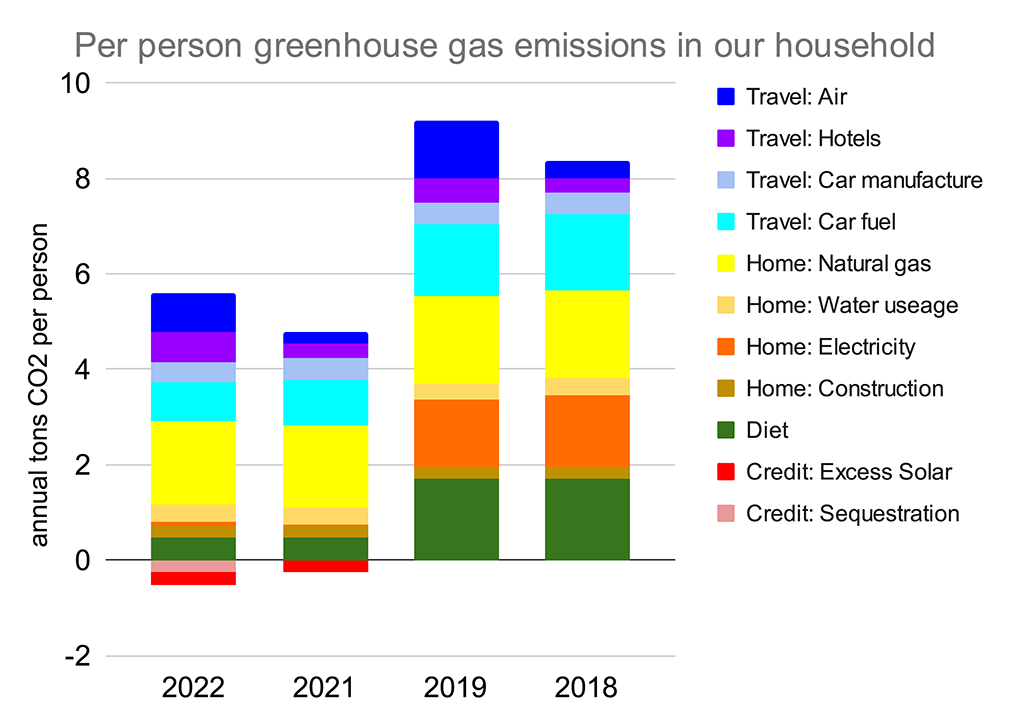How 5 Actions Cut My Emissions 45%
I reduced my greenhouse gas emissions 45% over the course of a few years as a result of five actions. I didn’t reduce my emissions alone. Emissions are easiest to calculate, and most effectively shifted, at the level of a household. So all of my references to “I” could be replaced by “Celeste and I.” And our household emissions are simply double my individual emissions.
I use 2018 and 2019 as my baseline years. At that time I was already taking some actions to limit my emissions, like driving a Prius, buying a house in a walkable community, frequently replacing beef with chicken or pork, and staying at friends houses when I traveled for my advocacy work. But as 2019 concluded I hadn’t quantified my emissions or committed to reduce them.
Here are the five actions I took along with the cuts in my emissions.
I installed solar panels and cut 1.5 tons CO2/year per person.
At the end of 2019 I had rooftop solar panels installed. This cut my electricity use to a net-negative. I do pay for some electricity in the summer when the air conditioning uses a bit more energy than I produce, but I also give a larger block of excess electricity I generate back to Duke Energy Progress for free around the first of June each year when the company zeros-out my forwarding credits. The system was designed to accommodate an electric car, though I did not have one at the time. This took an initial capital investment, and the payback period without the electric car fuel savings is 12 years, much shorter than the expected life of the panels.
I bought an electric car and cut 0.7 tons CO2/year per person
In 2020, Celeste and I replaced the 15 year old Acura with a Tesla Model Y. This reduced our gasoline consumption as we powered one automobile with electricity from our solar panels. Another capital intensive action, though there are a broad suite of cheaper options for electric vehicles on the market that are in range for any new car buyer.
I changed to a vegetarian diet and cut 1.2 tons CO2/year per person
I remain surprised by the magnitude of the emissions required to produce the foods we eat, especially meat. The shift in my diet was also encouraged by my doctor as my cholesterol levels are slowly climbing as I age, and he recommended trying a shift in my diet or starting a prescription medication. At the end of 2020 Celeste and I made this change together. Our current diet is mostly vegan with the consumption of eggs, consumption of fish and chicken about once a month, and consumption of cheese on our occasional pizza. But the only time we’ve purchased meat or dairy from the grocery store in the last 2 years has been when we needed it for company. This change did not require any capital and saved money from the first trips to a grocery store and restaurant.
I reduced my air travel and cut 0.2 tons CO2/year per person
Celeste and I are still working on this initiative - to eliminate air travel. Celeste was accepted into a 3-year program, one of her life goals, which required her to be in Phoenix 4 times over the course of 2021 to 2023. Phoenix is not a drivable destination for us, and rail connections are less than convenient from North Carolina. For one of those trips in 2022 I joined her and we spent an extra week in Tucson - and when she was in class I drove to visit my sister in New Mexico who I had not seen face-to-face in a decade. Our reduction in air-travel is still a behavioral change we are working on and offers a further reduction of 0.2 to 0.8 ton of CO2 per person per year.
I paid for the sequestration of 0.25 tons CO2/person
I have been exploring effective off-sets that a person (or organization) can buy for greenhouse gas emissions. In 2022 I paid $600 to climeworks for the capture and sequestration in bedrock of half a ton of CO2 (quarter ton per person in our household).
I hope these actions trigger a conversation in your household about the actions you can take to reduce your greenhouse gas emissions. In subsequent blog posts, I’ll write more about these actions.
For the United States to reduce our national emissions it will take actions by each of us to accept responsibility for the actions we choose that cause emissions. In the United States, I hold that legislators will not enact laws demanding voters take actions they are not willing to take on their own. I view actions to reduce my emissions as both a valid response to understanding the consequence of my emissions and also as a prerequisite to effectively communicating with my elected legislators in Washington and our state capitals. Furthermore, to influence our market economy, companies respond to one thing - where you spend your money. Our actions and choices do matter.
I am willing to help you calculate your emissions for 2022 as a place to further your understanding of the emissions you might reduce - just drop me a note. If you’re looking for a place to start your own household emission estimate on your own, I suggest beginning at UC Berkeley’s CoolClimate Calculator at https://coolclimate.berkeley.edu/calculator.
Please share your actions, ideas and suggestions on the co2mmit contact form, on Twitter, Instagram or in our Facebook Group.

